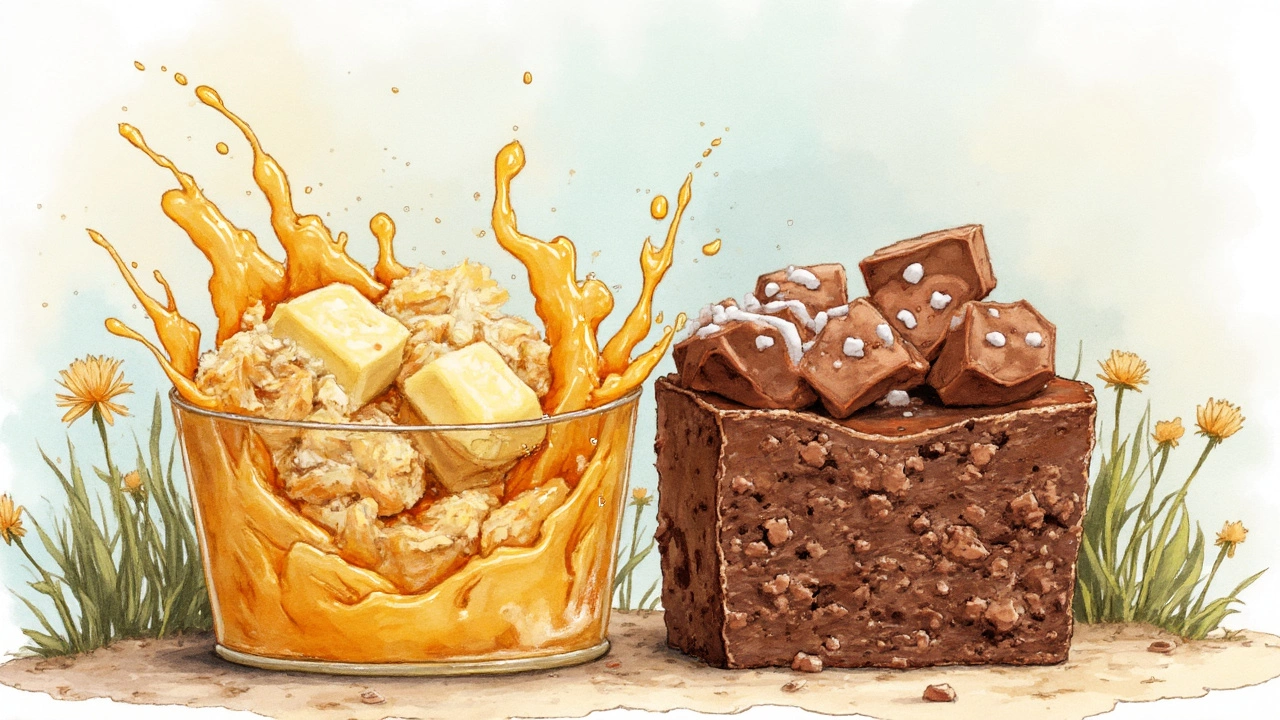
When it comes to fudge, there's a delightful debate about which texture rules supreme. Some folks can't resist the creamy, almost dissolving texture of soft fudge, while others crave the firm bite of a hard piece. Wondering which team you belong to?
To get the texture just right, it's all about balance and technique. Soft fudge often requires just the right temperature and precise timing, allowing sugar crystals to form perfectly for that melt-in-your-mouth experience. On the other hand, if you're aiming for a more traditional, firmer result, patience is your best friend—let it simmer a tad longer or adjust the cooling method.
Diving into ingredients, using different types of sugars, creams, and cooking times can totally transform your fudge. It's almost like a fun science experiment, only much tastier!
- Texture Matters
- Ingredients Impact
- Techniques to Try
- Regional Preferences
- Common Mistakes
- Secrets from the Experts
Texture Matters
Ask any fudge enthusiast, and you'll find texture is a big deal in the fudge universe. The debate often boils down to two camps: the soft fudge lovers and the hard fudge aficionados.
All About the Soft Touch
Soft fudge is often described as creamy and smooth. It melts almost instantly on your tongue. Achieving this texture is all about temperature control. You generally want to heat it to a lower temperature, allowing it to cool just under 112°C (around 233°F). This helps sugar crystals form in a way that stays soft and velvety.
The Firm Supporters
For those who love the firmer side of things, cooking your fudge recipe to a slightly higher temperature is key. Aim for around 116°C (about 240°F) to get that perfect, crisp bite. This is called the firm-ball stage in candy-making circles—it's the consistency where sugar forms slightly larger crystals.
Temperature Talk
But here's a pro tip: don't just rely on a thermometer. The cold water test, where you drop a bit of fudge into cold water to see if it forms a ball, is a great backup method. This way, you can adapt even if your equipment's a little off.
Factors at Play
Beyond just temperatures, factors like humidity and the type of sugar can influence the final texture of your fudge. Higher humidity can make it harder to achieve the right firmness, so some fudge makers use dehumidifiers or make it on dry days.
The Versatility of Fudge
A fun tidbit: fudge was first created sometime in the late 19th century, and it was all about improvisation. People learned over time that slight changes in ingredients and methods could create completely different confections. So, whether soft or firm, the adaptability of fudge is part of its charm.
Finally, always remember to let your fudge cool completely at room temperature, allowing it to set just right. Refrigerating too early can strip away all your hard work by messing with the sugar crystals.
Ingredients Impact
When making fudge, the ingredients play a starring role in whether it turns out soft or hard. Understanding how each ingredient affects texture can help you create your dream fudge.
Sugar Types
First things first—sugar. It’s not just about sweetness; it’s about structure. Using granulated sugar tends to give you a firmer fudge, while confectioners’ sugar will result in a softer, smoother texture. If you're experimenting and switch to brown sugar, prepare for a slightly softer result with a hint of molasses flavor.
Dairy Dilemmas
Let's talk dairy. Heavy cream is a common choice for richer, creamier fudge, which leans softer, while using milk instead may lead to a denser, firmer treat. Some recipes even call for evaporated milk, which is somewhere between the two.
Cocoa Considerations
The type of cocoa or chocolate also makes a big difference. Pure cocoa powder gives the fudge a more intense chocolate flavor and a slightly firmer finish compared to milk chocolate, which is creamier and softer due to its milk fat.
Additives & Extras
Adding butter is almost always a hit for flavor, but don’t underestimate its role in texture—it promotes a smooth, creamy finish. Vanilla extract is common for flavor, but watch out for any additional ingredients added for texture changes.
Fun Fact
Did you know that most professional fudge makers actually use a thermometer to ensure their sugar reaches around 234°F (soft ball stage) which is crucial for determining whether your fudge ends up delectably soft or satisfyingly durable?
Finding the right combination of ingredients can be the difference between a superb fudge that's either silky or snappy. A little experimentation can go a long way, so tailor your recipe to your texture preference!
Techniques to Try
Alright, let's get into the nitty-gritty of making the perfect fudge. Whether you love it soft or hard, these techniques will help you nail the texture you crave.
Soft Fudge Techniques
For those who prefer their fudge soft and creamy, precision in temperature is key. Here's what you need to do:
- Calibrate Your Candy Thermometer: Make sure your thermometer is accurate by testing it in boiling water. It should read 212°F (100°C). Adjust your recipe based on any difference.
- Slow and Steady: Cook the fudge mixture slowly, allowing it to reach approximately 235°F to 240°F, also known as the 'soft ball stage.'
- Gentle Cooling: Let your cooked fudge sit without stirring until it cools to around 110°F before beating it into a creamy consistency.
Hard Fudge Techniques
If a firmer bite is what you're after, try enhancing your hard fudge game with these steps:
- Higher Temperature: Cook the mixture to a slightly higher temperature of around 245°F (the 'firm ball stage') for more set results.
- Thorough Stirring: As it cools, stir the fudge vigorously once it drops to 110°F. This helps in forming smaller sugar crystals, giving you a firmer texture.
- Faster Cooling: Try cooling your fudge on a marble slab if you have one, or in a cool pan, to speed up the process and firm it up faster.
Additional Tips
Remember, humidity can mess with your fudge. On particularly damp days, give it a little extra time to dry and set properly. Also, patience is your best friend when making fudge—rushing through any of these steps can mean the difference between success and a sticky mess.

Regional Preferences
Believe it or not, where you're from might influence if you prefer soft fudge or its firmer cousin. Different regions have their own takes on what makes the perfect piece of fudge, and these preferences can sometimes surprise you.
The American Sweet Tooth
In the United States, the classic, creamy variety wins many hearts. American fudge fans often enjoy a softer texture, reminiscent of melt-in-your-mouth chocolatey goodness. This preference for creaminess can be traced back to its origins—fudge is said to have been born when a batch of caramel went 'fudged up' in the late 19th century. Since then, sweet and soft has been popular across the nation.
The British Take
Hop across the pond, and you'll find that the British prefer their fudge a bit firmer. It's a texture that echoes their tradition of toffee and other delightful, chewy sweets. This preference for a harder bite makes sense, as it holds to British baking traditions that tend toward the robust.
A Global Perspective
Interestingly, Ireland and Scotland lean towards a more buttery and crumbly version called tablet, which is almost like hard fudge but not quite. It crumbles as you bite into it, offering a unique eating experience that's both satisfying and distinctly regional.
In Australia, they love incorporating local ingredients like macadamia nuts and native Bushfoods into their fudge, giving their confections a unique twist. These additions tend to make the fudge there slightly denser and, often, harder.
"Fudge is a beloved treat wherever you go, but much like accents, every region has its own way of doing things," says Julia Collins, a renowned confectionery expert.
So, whether you’re biting into a piece of traditional American soft fudge or enjoying a slice of crumbly Scottish tablet, there’s no denying the charm of regional preferences. And who said sweets can't be cultural?
Common Mistakes
Even the most seasoned fudge enthusiasts make blunders now and then. If you're finding your sweet love turning into a disaster, it might be due to one of these common issues.
Temperature Troubles
One of the biggest culprits of fudge mishaps is improper temperature control. Whether you're aiming for soft fudge or a hard fudge texture, using a candy thermometer is a must. Many think they're close enough by just guessing, but even a few degrees can completely change the outcome.
Rushing the Process
Our busy lives often mean we’re in a hurry, but rushing fudge is a big no-no. Allow your mixture to reach the right temperature before you even think about transferring it to a pan. If your fudge isn’t setting right, patience (or the lack of it) is often to blame.
Poor Ingredient Choices
The type of sugar and cream you use can make a big difference. Some folks might try to use substitutes like low-fat milk or artificial sweeteners, but that generally sacrifices texture and flavor. Stick to the traditional ingredients for the best results.
Overworking the Mixture
Once you've poured your fudge into a pan, step away. Constantly stirring and fiddling with it will disrupt sugar crystal formation, leading to a gritty texture.
Ignoring Humidity
Humidity can play a tricky role in making fudge recipes come to life. A high humidity day might mean a longer cooking time. A pro tip? Try making fudge on dry days for the easiest results.
By avoiding these pitfalls, you'll be well on your way to making the perfect batch every time!
Secrets from the Experts
Ever wondered how to get that perfect fudge texture every time? We’ve gathered tips from top candy makers so you can keep your fudge game on point, no matter if you're making soft fudge or hard fudge.
Precise Temperature Control
According to dessert chef Mia Watson, the key to perfect fudge lies in mastering your candy thermometer. She suggests keeping a close eye on the temperature and making sure it hits just the right point. For soft fudge, aim for around 232°F (111°C). For harder fudge, you might want to let it reach 240°F (115°C).
The Role of Ingredients
Culinary expert Jordan Lewis advises that the type of sugar and dairy can dictate your fudge's final feel. Using granulated sugar typically suits hard fudge, while a mix of sugars, like brown and powdered, can help create that dreamy soft fudge.
Creaminess Factors
Adding good quality butter and heavy cream can make a world of difference. Leah Singh, a fudge aficionado, mentions using European-style butter for its higher fat content, which makes the fudge richer and creamier whether you're going for a hard or soft texture.
A Whisk of Patience
Whisking, it turns out, is an art. Being patient and not rushing through can prevent unwanted sugar crystals. June Parker, known for her silky fudge, swears by a slow, steady stir until a beautiful gloss forms on top.
Final Pro Tips
Lastly, remember that ambiance matters too! Cool, dry kitchen environments give the best results. If you let your fudge cool naturally without disturbing it, you’re more likely to achieve the perfect texture. Consistency is key!
Follow these expert tips, and your fudge recipes will never taste bland or have the wrong bite again!